Rare earth Er contained SnZn based leadless solder and its preparation method
A lead-free solder and rare earth technology, applied in welding equipment, manufacturing tools, metal processing equipment, etc., can solve the problems of not being suitable for large-scale use, increasing the crystallization temperature range, reducing the plasticity of solder joints, etc., and improving the spreading process Effects of performance, microstructure refinement, and increased purity
- Summary
- Abstract
- Description
- Claims
- Application Information
AI Technical Summary
Problems solved by technology
Method used
Image
Examples
example 1
[0022] Example 1: 26 grams of potassium chloride and 20 grams of lithium chloride mixed salt were melted at 460°C and poured on 94 grams of tin. Raise the temperature of the furnace to 620°C to melt the tin and the mixed salt, then add 5 grams of Zn to the tin liquid while stirring continuously to form an alloy; use a stainless steel bell jar with holes on the wall to quickly press 1 gram of rare earth Er into the Among the above molten alloys, and keep stirring until the rare earth is completely melted. Keep warm for 1 hour, stirring constantly to homogenize the alloy. Stand still and take out the furnace, and remove the mixed salt on the surface after the alloy is solidified. Lower the furnace temperature to 360°C to reheat and melt the solder block, and then pour it into strips on the angle iron for use.
example 2
[0023] Example 2: 26 grams of potassium chloride and 20 grams of lithium chloride mixed salt are poured on 92.5 grams of tin after melting at 460 ° C. Raise the temperature of the furnace to 780°C to melt the tin and the mixed salt, then add 7 grams of Zn to the tin liquid while stirring continuously to form an alloy; use a stainless steel bell jar with holes on the wall to quickly press 0.5 grams of rare earth Er into the Among the above molten alloys, and keep stirring until the rare earth is completely melted. Keep it warm for 1.5 hours and keep stirring to homogenize the alloy. Stand still and take out the furnace, and remove the mixed salt on the surface after the alloy is solidified. Lower the furnace temperature to 380°C to reheat and melt the solder block, and then pour it into strips on the angle iron for use.
example 3
[0024] Example 3: 23.4 grams of potassium chloride and 18 grams of lithium chloride mixed salt are poured on 90.75 grams of tin after melting at 490°C. Raise the temperature of the furnace to 680°C to melt the tin and the mixed salt, then add 9 grams of Zn to the tin liquid while stirring continuously to form an alloy; use a stainless steel bell jar with holes on the wall to quickly press 0.25 grams of rare earth Er into the Among the above molten alloys, and keep stirring until the rare earth is completely melted. Keep warm for 1 hour, stirring constantly to homogenize the alloy. Stand still and take out the furnace, and remove the mixed salt on the surface after the alloy is solidified. Lower the furnace temperature to 360°C to reheat and melt the solder block, and then pour it into strips on the angle iron for use.
PUM
 Login to View More
Login to View More Abstract
Description
Claims
Application Information
 Login to View More
Login to View More - R&D
- Intellectual Property
- Life Sciences
- Materials
- Tech Scout
- Unparalleled Data Quality
- Higher Quality Content
- 60% Fewer Hallucinations
Browse by: Latest US Patents, China's latest patents, Technical Efficacy Thesaurus, Application Domain, Technology Topic, Popular Technical Reports.
© 2025 PatSnap. All rights reserved.Legal|Privacy policy|Modern Slavery Act Transparency Statement|Sitemap|About US| Contact US: help@patsnap.com


